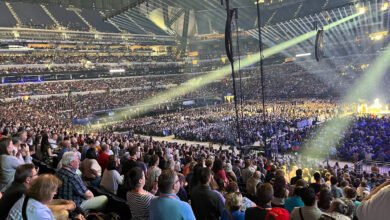
(RNS) — I thought the need for this conversation would have disappeared.
Like, a few decades ago.
I cannot believe I have to say this.
Again.
But, here goes.
The other day, I was talking to someone about a friend of mine who had converted to Judaism, a.k.a., joined the Jewish people.
My conversation partner stopped me in my tracks.
“I don’t believe in that,” he said. “You can’t convert to Judaism. You can’t just join the Jewish people. You either are Jewish, or you are not. What — you take a class, and you take a test and they dunk you (in the mikveh, the ritual bath) and poof — you’re Jewish?!?”
“No!” he continued. “You have to have a yiddishe neshame, a Jewish soul. You have to have centuries of suffering and feeling. It has to be in your DNA!”
I will tell you what went “poof,” at that moment.
2,500 years of Jewish history, law and theology went “poof.”
More than 40 years as a congregational rabbi working with Jews-by-choice went “poof.”
More than 40 years of being an activist and a leader in the Reform movement working to welcome Jews-by-choice went “poof.”
More than 40 years of having colleagues in Jewish professional life who are Jew-by-choice went “poof.”
And, let us be clear: Thousands of years of people joining the Jewish people to live Jewish lives and sometimes, tragically, to die Jewish deaths, went “poof.”
So, let me say it again — just in case you were not listening decades ago, or just in case you are new to this topic.
Judaism is not a closed club.
Judaism is not a secret society.
Judaism is not in your DNA. Actually, there are genetic elements of having ethnic Jewish ancestry. Every week, countless people are finding out, via 23 and Me, that they are, in fact, some percentage Jewish.
But, therein lies the paradox. The Jews are a tribe, a family, a people and a nation — into which you do not have to be born, but in fact, that you can join.
Is it easy to feel that sense of connection, and that sense of history? No.
Can you learn it? Absolutely. And it happens all the time.
Since the very beginning of Jewish history, people have sought to join us. Who were the first converts, or Jews-by-choice, or gerim? Abram and Sarai, whose names would become Abraham and Sarah. That is why Jews-by-choice take, as their Hebrew names, X ben or bat Avraham avinu v’Sarah imeinu — a Hebrew name, plus son or daughter of Abraham our father and Sarah our mother.
That is why the great medieval philosopher, Maimonides, told Ovadiah, who was a convert, that he (Ovadiah) should pray the traditional Jewish prayer that speaks of “the God of our ancestors,” because those ancestors are Ovadiah’s ancestors as well.
In fact, it is a classless violation of Jewish etiquette to refer to someone who has joined the Jewish people as a “convert,” or a “Jew by choice,” or a ger/giyoret.
They are Jews. Period. Full stop. End of sentence.
But, wait. Sure, you can convert to a religion. But, can you become part of a people?
Go back in history and ask the biblical Ruth.
Ruth was a Moabite woman, and the Torah had barred the Moabites from associating with the Jewish people.
And yet, Ruth and her sister, Orpah, married into a Judean family. When their husbands died, Ruth wanted to leave Moab and accompany her mother-in-law, Naomi, back to Judah.
When Naomi pushed back on that request, what did Ruth say to her? “Your people will be my people, and your God will be my God.” Note the order: first, peoplehood; then, religion.
When was the book of Ruth written? Probably after the Judeans returned from Babylonian exile, around the year 400 BCE. The Judeans interacted with many foreign peoples, and the anonymous author of Ruth knew there were at least two ways of dealing with foreigners who lived in the midst of the Jewish people. (I write about this in my book “Righteous Gentiles in the Hebrew Bible: Ancient Models for Sacred Relationships”).
First, there was the “Ezra” model. When the Judeans ended their exile in Babylonia and returned to the land of Israel, their leaders, Ezra and Nehemiah, wanted to reconstitute the Jewish people as a unified ethnic group.
To that end, Ezra prohibited all intermarriage with local residents of the land of Israel, which included the Moabites (Ezra 9:1). Ezra was overly zealous and more than a little ethnocentric. Israel was “holy seed” (Ezra 9:3); by contrast, once a gentile, always a gentile.
But there was another model — the “Ruth” model.
The author of Ruth told a different story. A Moabite woman found shelter within the Jewish people. More than that: King David has Moabite blood in his veins. And so, therefore, will the ultimate Messiah.
I understand the “Ezra” model. But I don’t like it (it’s “Ruth”-less). I don’t like the modern, vulgar manifestations of that model: terms like goy, goyim, goyische, shiksa (a gentile woman), and sheygetz (a gentile man).
Why does the anti-convert/Jew-by-choice thing bother me so much?
First: I take it personally. It affects people I love.
But, second: it has everything to do with this present moment in Jewish history.
From the Jewish Telegraphic Agency:
Jasamine Hodge started converting to Judaism eight years ago, but it wasn’t until Oct. 7 that she set a date to finish …
When Hamas struck Israel on Oct. 7, killing about 1,200 people and taking hundreds of hostages, she felt the gap in her identity acutely.
“When the attack happened, I just felt this urgency to be even more connected with God because I felt that every single prayer, with so many against us, was needed right now,” Hodge said. “As I continued to elevate my prayers and elevate my closeness to God, I realized that this was the time more than ever that I needed to push things to the finish line.”
Hodge is not the only person to experience a pull toward conversion after Oct. 7. Multiple rabbis told the Jewish Telegraphic Agency that they have seen a surge in interest from potential converts since the attack, both from people who were already in the process of converting and from people who had never before been in touch. The surge has taken place even as the attack and the ensuing war between Israel and Hamas have fueled antisemitic incidents around the world.
To be clear: She was in the process of converting; got diverted from that goal — and then resumed, full force, after Oct. 7.
Which is ironic. According to the Shulchan Arukh, the classic code of Jewish law (Yoreh Deah 268), when someone comes to Jewish authorities and seeks to join the Jewish people, this is what happens:
“When a person comes to convert, say to him, ‘What did you see that motivated you to come to convert? Don’t you know that the Jewish people, in this time, are oppressed and suffering?’ If he says, ‘I know this, and I will still become a part of your people,’ receive him immediately …”
Present-day equivalent: Don’t you know the Jewish people, in this time, are the subject of international revulsion? Don’t you know Jew-haters march on college campuses? Don’t you know a terrorist group has sworn to kill Jews? Don’t you know Jews are subject to attack, every single day?
Imagine, now, the candidate who says: “I know this, and I will still become a part of your people.”
People want to be Jewish — now? Even, now?
Especially now.
Welcome — in the name of God.
Source link




